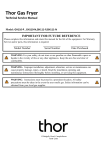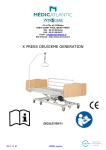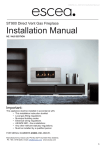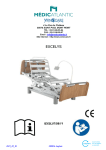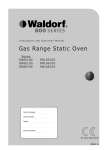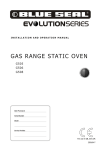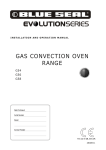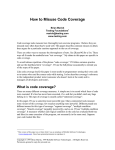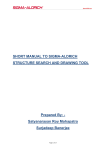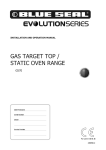Download 幻灯片 1 - Nisbets
Transcript
Thor Gas Hot Plate Technical Service Manual Model: GH107-P , GH107-N IMPORTANT FOR FUTURE REFERENCE Please complete this information and retain this manual for the life of the equipment. For Warranty Service and/or parts, this information is required. Model Number Serial Number Date Purchased WARNING: For your safety, do not store or use gasoline or other flammable vapors or liquids in the vicinity of this or any other appliances. Keep the area free and clear of combustible. WARNING:Improper installation, adjustment, alteration, service or maintenance can cause property damage, injury, or death. Read the installation operating and maintenance instructions thoroughly before installing, or servicing this equipment. WARNING:Instructions must be posted in a prominent location. All safety precautions must be taken in the event the user smells gas. Safety information can be obtained from your local gas supplier. 15 Badgally Road, Campbelltown NSW 2560 Table of Contents Introduction 1 Specification 2 Dimensions 3 Installation 4~6 Operation 7~9 Cleaning and Maintenance 10 ~ 12 Troubleshooting 13 ~ 23 Conversion from NG to LPG and vice-versa 22 Explosion Drawing (ALL PARTS) 24 Parts List 25 ~ 26 Explosion Drawing (SPARE PARTS) 27 Spare Parts List 28 Introduction We are confident that you will be delighted with your Thor Gas Hot Plate, and it will become a most valued appliance for you. To ensure you receive the utmost benefit from your new Gas Hot Plate, there are two important things you need to do. Firstly: Please read the instruction book carefully and follow the directions given. The time taken will be well spent. Secondly: If you are unsure of any aspect of the installation, instructions or performance of your appliance, contact your dealer promptly. CE Only: These instructions are only valid if the country code appears on the appliance. If the code does not appear on the appliance, refer to the supplier of this appliance to obtain the technical instructions for adapting the appliance to the conditions for use in that country. WARNING: IMPROPER INSTALLATION, ADJUSTMENT, ALTERATION, SERVICE OR MAINTENANCE CAN CAUSE PROPERTY DAMAGE, INJURY OR DEATH. READ THE INSTALLATION, OPERATING AND MAINTENANCE INSTRUCTIONS THOROUGHLY BEFORE INSTALLING OR SERVICING THIS APPLIANCE. WARNING: INSTRUCTIONS TO BE FOLLOWED IN THE EVENT THE USER SMELLS GAS ARE TO BE POSTED IN A PROMINENT LOCATION. THIS INFORMATION SHALL BE OBTAINED BY CONSULTING THE LOCAL GAS SUPPLIER. WARNING: GREAT CARE MUST BE TAKEN BY THE OPERATOR TO USE THE EQUIPMENT SAFELY TO GUARD IT AGAINST RISK OF FIRE. • THE APPLIANCE MUST NOT BE LEFT ON UNATTENDED. • IT IS RECOMMENDED THAT A REGULAR INSPECTION IS MADE BY A COMPETENT SERVICE PERSON TO ENSURE CORRECT AND SAFE OPERATION OF YOUR APPLIANCE IS MAINTAINED. • DO NOT STORE OR USE GASOLINE OR OTHER FLAMMABLE VAPOURS OR LIQUIDS IN THE VICINITY OF THE APPLIANCE. • NOT SPRAY AEROSOLS IN THE VICINITY OF THIS APPLIANCE WHILE IT IS IN OPERATION. CAUTION: THIS APPLIANCE IS; • FOR PROFESSIONAL USE AND IS TO BE USED BY QUALIFIED PERSONS ONLY. • ONLY QUALIFIED SERVICE PERSONS ARE TO CARRY OUT INSTALLATION, SERVICING AND GAS CONVERSION OPERATIONS. • COMPONENTS HAVING ADJUSTMENTS PROTECTED BY THE MANUFACTURER SHOULD NOT BE ADJUSTED BY THE USER/OPERATOR. • DO NOT OPERATE THE APPLIANCE WITHOUT THE LEGS SUPPLIED FITTED. 1 Specification General Commercial heavy duty hot plate with cast iron trivets and burners, and fitted with full pilot and flame failure protection. Pack Contents The following is included: Thor Gas Hot Plate Feet Instruction Manual Gas Supply Requirements Natural Gas Propane GH107-N GH107-P Single burner Heat Input 32.5 MJ 32.5 MJ Heat Total 130.0 MJ 130.0 MJ 1.0kPa 2.75kPa Supply Pressure 1.0kPa 2.75kPa Gas Connection ¾” BSP ¾” BSP Burner Operating The burner operating pressure is to be measured at the manifold test point with two burners operating at full setting. The operating pressure is ex-factory set, through the appliance regulator and is not to be adjusted. Minimum input Heat of burner: 21MJ for LPG AND NG Size of the pan: The biggest pan for open burner is 280mm. 2 Dimensions GH107-P / GH107-N 3 Installation Installation Requirements NOTE: • It is most important that this appliance is installed correctly and that operation is correct before use. Installation shall comply with local gas, health and safety requirements. • This appliance shall be installed with sufficient ventilation to prevent the occurrence of unacceptable concentrations of substances harmful to health. Our Gas Hot Plates are designed to provide years of satisfactory service and correct installation is essential to achieve the best performance, efficiency and trouble-free operation. This appliance must be installed in accordance with National installation codes and in addition, in accordance with relevant National / Local codes covering gas and fire safety. Australia: AS 5601/AG 601 (to be AS 5601)- Gas Installations New Zealand: NZS 5261 - Gas Installation. United Kingdom: Gas Safety (Installation and Use) Regulations 1998 BS 6173-Installation of Catering Appliances. BS 5440-1&2 Installation Flueing & Ventilation. Ireland: IS 820-Non Domestic Gas Installations. Installations must be carried out by qualified persons only. Failure to install equipment to the relevant codes and manufacturer’s specifications shown in this section will void the warranty. Components having adjustments protected by the manufacturer are only to be adjusted by an authorized service agent. They are not to be adjusted by the installation person. Unpacking • Remove all packaging and transit protection from the appliance including all protective plastic coating from the exterior stainless steel panels. • Check equipment and parts for damage. Report any damage immediately to the carrier and distributor. • Ensure that the 4 adjustable feet are fitted with the protruding centre screw. • Report any deficiencies to the distributor who supplied the appliance. • Check that the available gas supply is correct to that shown on the rating plate located on the right hand panel. Location 1. 2. 3. 4. 5. 6. Installation must allow for a sufficient flow of fresh air for the combustion air supply. Installation must include adequate ventilation means, to prevent dangerous build-up of combustion products. Any gas burning appliance requires adequate clearance and ventilation for optimum and trouble-free operation. The minimum installation clearances shown below are to be adhered to. Position the appliance in its approximate working position. All air for burner combustion is supplied from underneath the unit. The legs must always be fitted and no obstructions placed on the underside or around the base of the unit, as obstructions will cause incorrect operation and / or failure of the appliance. Components having adjustments protected by manufacturer are only allowed to be adjusted by an authorized service agent. They are not to be adjusted by the installation person. 4 Installation Clearances NOTE: Only non-combustible materials can be used in close proximity to this appliance. Combustible Surface Non Combustible Surface Left / Right Hand Side 250mm 0mm Rear 250mm 0mm Assembly NOTE: • This appliance is assembled before delivery except feet. • This appliance is fitted with adjustable feet to enable the appliance to be positioned securely and level. This should be carried out on completion of the gas connection. Refer to the ‘Gas Connection’ section. • IM will be stated that the appliance shall be installed in such a way that side body surfaces are not accessible in the installed position. Gas Connection NOTE: ALL GAS FITTING MUST ONLY BE CARRIED OUT BY A QUALIFIED PERSON. 1. 2. The Gas Hot Plates do not require an electrical connection, as they function totally on the gas supply only. It is essential that the gas supply is correct for the appliance to be installed and that adequate supply pressure and volume are available. The following checks should therefore be made before installation:a. Gas Type required for the appliance is shown in the rating label. Check that this is correct for the gas supply the appliance is being installed for. The gas conversion procedure is detailed in this manual. b. Supply Pressure required for this appliance is shown in the ‘Gas supply requirements’ section of this manual. Check the gas supply to ensure adequate supply pressure exists. c. Input Rate of this appliance is stated on the Rating label .The input rate should be checked against the available gas supply line capacity. Particular note should be taken if the appliance is being added to an existing installation. NOTE: It is important that adequately sized piping runs directly to the connection joint on the appliance with as few tees and elbows as possible to give maximum supply volume. NOTE: Ensure the regulator is converted to the correct gas type that the appliance will operate on. The regulator outlet pressure is fixed ex-factory for the gas type . 3. 4. 5. Correctly locate the appliance into its final operating position and using a spirit level, adjust the legs so that the unit is level and at the correct height. Connect the gas supply to the appliance through the regulator. (refer to the picture of “Install the Regulator”). A suitable jointing compound which resists the breakdown action of propane must be used on every gas line connection, unless compression fittings are used. Check all gas connections for leakages. W A R N I N G: DO NOT USE A NAKED FLAME TO CHECK FOR GAS LEAKAGES. 5 Installation 6. Check that the gas operating pressure. NOTE: The operating pressure to be measured at the manifold test point and with 2 burners operating at the ‘High Flame’ setting. 7. 8. 9. Turn off the mains gas supply and bleed the gas out of the appliance gas lines. Turn on the gas supply and the appliance. Verify that the operating pressure remains correct. Commissioning 1. Before leaving the new installation; a. Check the following functions in accordance with the operating instructions specified in the ‘Operation’ section of this manual. • Light the Pilot Burner. • Light the Main Burner. • Turning 'Off' the Main Burner/Pilot. b. Ensure that the operator has been instructed in the areas of correct lighting, operation, and shutdown procedure for the appliance. 2. This manual must be kept by the owner for future reference and a record of the Date of Purchase, Date of Installation and the Serial Number of the Appliance must be recorded and kept with this manual. (These details can be found on the Rating label, refer to the ‘Gas Connection’ section). NOTE: If for some reason it is not possible to get the appliance to operate correctly, shut off the gas supply and contact the supplier of this appliance. Nameplate Install the Regulator 6 Operation Operation Guide CAUTION: • This appliance is for professional use and is only to be used by qualified persons. • Only authorized service persons are to carry out installation, servicing or gas conversion operation operations. • Components having adjustments protected by the manufacturer should not be adjusted by the user/operator. 1. The Gas Hot Plates have been designed to provide simplicity of operation and 100% safety protection. 2. Improper operation is therefore almost impossible, however bad operation practices can reduce the life of the appliance. To use this appliance correctly please read the following sections carefully: • Lighting the Main Burner. • Turning off the Main Burner / Pilot. 3. Please use wok with diameter of 240-280mm. Description of Controls 7 Operation 1. Lighting the Main Burners The hot plates are fitted with individual standing pilots for each open burner which allows the main burners to be turned ON- OFF without the need to manually re-light the burner each time that it is turned ON, as the burner will be automatically lit itself by the pilot burner. Flame Failure Protection is incorporated for each burner by way of a thermo-electric system which will shut off the gas supply to that burner in the event that the burner goes out, so that un-burnt gas is not expelled. 1. Select the burner required, depress and turn the corresponding gas control knob anti-clockwise to the ‘PILOT’ position. 2. With the gas control knob depressed, manually light the pilot burner or use the piezo igniter provided (optional). 3. Release the gas control knob after approximately 10-20 seconds after lighting the pilot burner. 4. The pilot burner should stay alight - if not, repeat Steps (b. to c. above.) 5. ‘Full Flame’ can now be achieved by depressing and rotating the gas control knob anti-clockwise to the first stop 'HIGH' flame position. 6. Low flame can be achieved by depressing the gas control knob and rotating fully anti-clockwise to the ‘LOW' flame position. 7. To achieve simmer control, depress the gas control knob and rotate between the ‘HIGH’ and ‘LOW’ positions to achieve the temperature required. 2. Turning 'OFF' the Open Burners / Pilots 1. To turn 'LOW' the main burner, but keep the pilot burner alight, rotate the gas control knob to the 'PILOT' position. The main burner will extinguish and the pilot will remain alight. 2. To turn 'LOW' the 'PILOT', depress and turn the gas control knob clockwise back to the ‘┃’ position. The 'PILOT' burner will extinguish. 8 Operation Main burner air supply: 1. For efficient burner operation, a proper balance of gas volume and primary air supply must be maintained which will result in complete combustion. Insufficient air supply results in a yellow streaming flame. Primary air supply is controlled by an air shutter on the front of the burner. 2. Loosen the screws on the front of the burner and adjust the air shutter to just eliminate the yellow tips of the burner flame. Lock the air shutter in place by tightening the screws. CAUTION The space between the legs at the bottom admits combustion air. DO NOT BLOCK THIS SPACE. All burners are lit from constantly burning pilots. Turning the valve to the desired flame height is all that is required to put the unit in service. Do not permit fans to blow directly at the unit. Wherever possible, avoid open windows next to the units' sides or back. Avoid wall type fans which create air cross-currents within a room. It is also necessary that sufficient air should be allowed to enter the room to compensate for the amount of air removed by any ventilating system. Otherwise, a subnormal atmospheric pressure will occur, affecting operation and causing undesirable working conditions. A properly designed and installed hood will act as the heart of the ventilating system for the room or area in which the unit is installed, and will leave the unit independent of changing draft conditions. All valves must be checked and lubricated periodically. This must be done by an authorized service representative in your area. Note: Please wait at least 15 seconds to restart the main burners to maintain the best function of the thermostat valve after turning off the main burners. IMPORTANT Should any abnormal operation like; - ignition problems, - abnormal burner flame, - burner control problems, - partial or full loss of burner flame in normal operation, be noticed, the appliance requires IMMEDIATE service by a qualified service person and should not be used until such service is carried out. 9 Cleaning and Maintenance CAUTION: Always turn off the gas supply before cleaning. This appliance is not water proof. Do not use water jet spray to clean this appliance. GENERAL Clean the Gas Hot Plate regularly. A clean Gas Hot Plate looks better, will last longer and will perform better. Carbonised grease on the surface or between the trivets, will hinder the transfer of heat from the cooking surface to the food. This will result in loss of cooking efficiency. DO NOT use water on the trivets, burners while these items are still hot as warping and cracking may occur. Allow these items to cool down and then remove for cleaning. The entire trivets burner can be dismantled for cleaning. NOTE: • DO NOT use abrasive detergents, strong solvents or caustic detergents as they could corrode or damage the Gas Hot Plate. • In order to prevent the forming of rust on the trivets, and burners, ensure that any detergent or cleaning material has been completely removed after each cleaning. DAILY CLEANING 1. 2. 3. The drip tray should be checked and emptied frequently to prevent overflow and spillage. Remove the drip tray while still warm so that the grease is in a liquid state. Empty any grease from the trays and wash thoroughly in the same manner as any cooking utensil. Remove the burner, the trivets and thoroughly clean the splash back, interior and exterior surfaces of the range with hot water, a detergent solution and a soft scrubbing brush. Dry the Gas Hot Plate thoroughly with a dry cloth and polish with a soft dry cloth. NOTE: • If the Hot Plate usage is very high, we recommend that the weekly cleaning procedure is carried out on a more frequent basis. • Ensure that protective gloves are worn during the cleaning process. • DO NOT use harsh abrasive detergents, strong solvents or caustic detergents as they will damage the grate and burners. • Allow these items castings to cool and remove for cleaning. • Parts protected by the manufacturer or his agent are not to be adjusted by the installer, unless the installer is an authorized service agent. Periodic Maintenance NOTE: All maintenance operations should only be carried out by a qualified service person. To achieve the best results cleaning must be regular and thorough and all controls and mechanical parts should be checked and adjusted periodically by a qualified service person. If any small faults occur, have them attended to promptly. Don't wait until they cause a complete breakdown. 10 Cleaning and Maintenance Trivets and Burners a. Remove the trivets from the top of the appliance (Refer to Pic1). b. Remove the burner from the top of the bracket of appliance (Refer to Pic2). c. The trivets and burners should be cleaned with a mild detergent and hot water solution using a soft bristled brush. Dry thoroughly with a dry cloth. Stainless Steel Surfaces a. With the trivet and burners removed, clean the interior and exterior surfaces of the Gas Hobs with hot water, a mild detergent solution and a soft scrubbing brush. Note that the gas control knobs are a push fit onto the gas control valve spindles and can be removed to allow cleaning of the front of the control panel. b. Baked on deposits or discolouration may require a good quality stainless steel cleaner or stainless steel wool. Always apply cleaner when the appliance is cold and rub in the direction of the grain. c. Dry all components thoroughly with a dry cloth and polish with a soft dry cloth. Pic1 Pic2 d. To remove any discolouration, use an approved stainless steel cleaner or stainless steel wool. Always rub in the direction of the grain. e. Remove the drip tray and clean with a mild anti bacterial detergent and hot water solution using a soft bristled brush. f. Dry the drip tray thoroughly with a dry cloth. 11 Cleaning and Maintenance NOTE: All maintenance operations should only be carried out by a qualified service person. To achieve the best results, cleaning must be regular, thorough and all controls and mechanical parts should be checked and adjusted periodically by a qualified service person. If any small faults occur, have them attended to promptly. Don't wait until they cause a complete breakdown. Gas Control Valve Re-Greasing The gas control valve should be dismantled and greased for a period of time to ensure the correct operation of the gas control valve. To carry out this operation: a. Remove the gas control knobs from the gas tap spindles by pulling the knobs away from the control panel. b. Remove the drip tray from the appliance. c. Remove the four screws on the underside of the control panel, securing the control panel to the hob. d. Remove the control panel from the front of the appliance. e. Remove the 2 screws holding shaft plate to gas control body and remove control shaft and plate. (Refer to Pic3). Note orientation of shaft for correct re-assembly. f. Using needle nose pliers or similar, pull out gas control spindle, again noting its orientation. g. Apply a suitable high temperature gas cock grease or lubricant such as ROCOL - A.S.P (Anti scuffing paste) / Dry Moly Paste to the outside of the spindle. (Refer to Pic4). h. Replace spindle and re-assemble the gas control in reverse order. i. Refit the control panel to the appliance and secure with 2 screws. j. Refit the knobs to the gas control valve spindles. Pic3 Two Screws Pic4 Spindle 12 Trouble Shooting This section provides an easy reference guide to the more common problems that may occur during the operation of your equipment. The fault finding guide in this section is intended to help you correct, or at least accurately diagnose problems with your equipment. Although this section covers the most common problems reported, you may encounter a problem not covered in this section. In such instances, please contact your local authorized service agent who will make every effort to help you identify and resolve the problem. Please note that the service agent will require the following information: • Model Code and the Serial Number of the appliance. (Both of them can be found on the Rating Plate located on the appliance). GENERAL INFORMATION BURNING SPEED: The velocity at which flame travels through an air-gas mixture. Burning speeds vary with types of gases, and the amount of air mixed with the gas. This air to gas ratio is very important in that it is directly related to flame stability. PRODUCTS OF COMBUSTION: Carbon dioxide and water vapor is formed in burning plus the nitrogen in the reactants that entered with the combustion air. FLUE PRODUCTS: The combination of combustion and excess air leaving the combustion area. Since water is produced as a vapor in the burning of gas it is also present in flue products. If the flue products and vent system remain hot enough this vapor is harmlessly discharged. If not, the vapor can reach the dew point and condense into water which can accumulate in the system. INCOMPLETE COMBUSTION: A poorly vented appliance restricts flow of air into an appliance. Lack of ventilation around an appliance may lower oxygen content in the surrounding air. This can be a result of spillage of combustion products into the room as well. These conditions can cause incomplete combustion and poor performance of an appliance. Adequate, but not excessive ventilation is a must and cannot be over emphasized. PRIMARY AIR: That air which is mixed with gas before the gas leaves the burner port to burn. Ideal burning condition generally is 10 cubic feet of air per cubic foot of gas. SECONDARY AIR: The remaining air needed for complete combustion besides primary air. This is the air surrounding the flames. FLAME STABILITY: Primary air, burning speed, port size and port depth are several factors affecting flame stability. Flames on a burner tend to stabilize at a point where flow velocity out and burning speed back are equal. This balance of flow velocities and burning speed explain why flames change when primary air or gas rate is adjusted. B.T.U.: British Thermal Units is the heat energy produced when burning a fuel gas. One BTU of heat will raise the temperature of one pound of fresh water one degree Fahrenheit. 13 Trouble Shooting BURNER PROBLEMS LIFTING BURNER FLAMES: Excessive primary air can cause flames to lift and blow off the burner ports which can be noisy as well as inefficient. More importantly however is the production of dangerous carbon monoxide under this condition. Any factor which reduces burning speed promotes lifting flames. Also, any factor which increases flow velocity from ports contributes to lifting flames. Overrating of burners is also a cause. The normal cure for lifting flames is the reduction of primary air input to the burner. FLASHBACK: Flashback occurs when gas-air flow velocity is less than burning speed at some point near a burner port. Flash back is a condition where gas ignites within the burner. Any factor which increases burning speed tends to promote flashback, and any factor decreasing flow velocity from the ports will contribute to flashback. Flashback is more prevalent with faster burning gases. Natural gas is relatively slow burning gas hence flashback is less likely. Reducing primary air is the usual cure for flashback. EXTINCTION POP: This is merely flashback occurring when a burner is turned off. It is usually instantaneous although it can occur several seconds after the burner has been turned off. What happens is that primary air continues to flow into the burner even though the gas jet has been cut off and does not inject air. The mixture in the burner changes from the normal operating mixture to all air and flow rate through the ports falls off toward zero. Under these conditions, it is possible for the flame speed to exceed flow velocity at some instant and flashback may occur. The result is a tiny explosion or pop. Since increasing primary air increases the burning speed, it is obvious that reducing primary air input will reduce the flashback tendency. YELLOW TIPPING OF FLAMES: Too severe a reduction in primary air also causes its problems. Yellow tipping is one of them. Flames will eventually become all yellow if no primary air is supplied. These yellow tips are caused by glowing carbon particles in the flame. Soot will form if these yellow flames impinge on cooler surfaces. Here again carbon monoxide can be produced. Yellow tipping is corrected by the injection of more primary air. FLUCTUATING FLAMES: Length of burner flames may fluctuate or shorten over a period of time with no re-adjustments of the burner. This condition usually indicates a non-uniform gas pressure at the orifice. Fluctuating flames usually do not create any immediate problems, such as incomplete combustion, unless flames impinge on cool surfaces. This condition should be corrected, however, since it warns of possible future problems. Unsteady gas pressures cause flames to fluctuate. Usually this condition indicates problems with the gas pressure regulator, the gas meter or other gas supply problems. Check the orifice for blockage by dust or dirt from supply lines. Very small pilot orifices are quite prone to blockage. Occasionally, too much grease in pilot valves restricts gas flow to pilot burners. Remove any excess greases. FLAME ROLLOUT: When the condition known as flame rollout occurs, flames roll out of the combustion chamber openings when the burner is turned ON. Flame rollout may create a fire hazard, or scorch appliance finishes, burn wire, or damage controls. The gas in the burner mixer may be ignited, producing flashback. Flame rollout is actually a variation of floating flames, with flames reaching for air outside the combustion chamber. Again, the basic cause is a lack of combustion air. This lack of air may be due to overrating of burners, poor draft or blockage of flueways. Apply the corrections for these problems listed for floating flames. Some appliances use step-type controls. These controls limit initial gas flow to the burner to establish natural draft in the appliance before full gas rate is allowed to flow. Check the operation of this control, and replace the control if it is faulty. 14 Trouble Shooting BURNER PROBLEMS– cont’d. FLOATING FLAMES: The difference between floating flames and lifting (or blowing) flames should be clearly understood. Both conditions are undesirable, but the causes and corrective steps are different. Floating flames are lazy looking. They do not have well defined cones, and appear to be “reaching” for the air. They are long, illdefined, quite flames which roll around in the combustion chamber sometimes completely off the ports. Usually a strong aldehyde odor is present. Floating flames almost always indicate incomplete combustion. They point to a dangerous condition which require prompt correction. If secondary air supply is reduced too far burner flames will float. Combustion products above the burner re-circulate lower in the chamber. These products contaminate the air supply, adding to the problem. A lack of combustion air causes burner flames to float. Several conditions, or a combination of these conditions can be the cause. The appliance may be overrated. If so, the flue outlet area provided for the rated input may be too small for the increase gas rate. Check appliance rate and reduce if necessary. Other conditions may cause poor venting and lead to floating flames. Soot or dust may be blocking flueways. Check flueways and clear any blockage found. Determine, if possible, the reason the flueways blocked up. Check for blockage of burners, and clean them if necessary. Adjust primary air to get rid of any yellow tipping which may have produced soot to block he flueways. Make sure secondary air inlet openings are not blocked. Reduced natural draft (venting) through an appliance may take place when it is operated from a cold start. Some floating flames may appear for a brief time until draft is established. When the appliance heats up it should operate in a normal manner. UNSTABLE OR WAVERING FLAMES: Drafts across burners may cause flames to waver or appear to be unstable. This condition should not be confused with lifting or floating flames. Wavering burner flames can lead to incomplete burning if flames impinge on cool surfaces. Pilot flames under drafts may go out, or they may be diverted from heating the sensing element of the automatic pilot device. In either case the automatic pilot will shut off gas supply to the appliance. Drafts affecting pilot flames may be simply external drafts, such as across the floor. Protect the pilot flames with suitable baffles. Draft-blown main burner flames may indicate a more serious problem, such as cracked heat exchanger. Replace or repair a cracked heat exchanger without delay. GAS ODOR AT PRIMARY AIR OPENINGS: Under normal burner operation, a negative pressure (vacuum) should exist inside the primary air openings of a burner, drawing in air. If all gas fed to the burner by the orifice does not flow to the burner head, some gas may spill from the primary air openings. If this condition is found, check the burner body for restrictions, and check the orifice to make certain it is not out of line. CORROSION OF APPLIANCES: Gas appliances are designed and built to give long dependable service life. In some installations recently, usually severe corrosion has occurred resulting in customer complaints. This corrosion is attributed to the extensive use of aerosol propellants, hydrocarbons which contain the elements FLOURINE AND CHLORINE. These elements are called halogens. Halogens in their free state are very corrosive. When the propellants pass through a flame, they break down and the halogen gases are released. In combination with the water vapor in the flue gases they cause corrosion in heat exchangers, flueways and other appliance parts. Some of the worst cases of this corrosion have been in beauty shops where hair sprays are used and in dry cleaning plants where halogen-containing materials are used as cleaning fluids. 15 Trouble Shooting PILOT TROUBLE SHOOTING Fault Pilot won’t light. Pilot goes out when gas control knob released. Pilot flame is yellow. Possible Cause Remedy No gas supply or gas isolation valve is OFF. Ensure gas isolation valve is turned on, and that gas tanks are not empty. Pilot burner is clogged/blocked. Check the pilot burner if clogged, and clean if necessary. Follow the pilot burner removal procedure. Pilot injector is clogged. Check the pilot injector if clogged, and clean if necessary. Follow the pilot injector removal procedure. Pilot injector is damaged. Check if the pilot injector is blocked/damaged, and replace it if necessary. Follow the pilot injector removal procedure. Releasing the knob before the thermocouple has heated. Hold the knob in for at least 10~20 seconds following ignition of the pilot. Gas pressure too low. Check the pressure of the main line if within standard. Adjust the pressure if necessary. NG – 1.0KPa and LPG – 2.75KPa. Partially blocked pilot injector. Clean the pilot injector or replace the pilot injector if necessary. Follow the pilot injector removal procedure. Thermocouple connection to the gas safety valve is loose. Tighten the thermocouple connection. Faulty thermocouple or FDS. Replace the thermocouple or FDS. Follow the thermocouple removal procedure. Faulty safety gas valve. Replace the safety gas valve. Follow the safety gas valve removal procedure. Pilot injector is clogged. Check the pilot injector if clogged, and clean if necessary. Follow the pilot injector removal procedure. 16 Trouble Shooting PILOT TROUBLE SHOOTING – cont’d.: CHECKING & CLEANING OF THE PILOT INJECTOR: 1. Visually check the orifice of the pilot injector if clogged, damaged or blocked. If it cannot be checked visually, try to blow air in the injector and check if there is air coming out of the orifice. 2. If the orifice is blocked or clogged, clean it by washing in a solvent or use an air blow to remove the clogging. Never pinch the orifice with a pin as this could damage the orifice. 3. If the clogging cannot be removed from the orifice by air blow, replace the injector with a new one. Remember to check the size of the orifice and replace with the same size. 4. Follow the pilot injector removal procedure. THERMOCOUPLE PILOT BURNER ODS MOUNTING SCREWS PILOT INJECTOR PILOT TUBE Disconnecting pilot tube from ODS Assembly’s pilot injector (Rear ODS) REAR PILOT INJECTOR REMOVAL: 1. Shut-off the main isolation valve and follow the lock-out/tag-out procedure. 2. Turn-off the pilot. 3. Remove the trivets. 4. Remove the burner. 5. Remove the lock nut of the thermocouple. Use 8mm spanner to remove the nut. (Optional for ease of access) 6. Remove the two mounting screws of the ODS. (Optional for ease of access) 7. Disconnect the pilot tube assy. from the pilot injector. Use 13mm spanner to disconnect the fitting. 8. Remove the pilot injector from the ODS Assembly. Use 10mm spanner to remove the injector. FRONT PILOT INJECTOR REMOVAL: 1. Shut-off the main isolation valve and follow the lock-out/tag-out procedure. 2. Turn-off the pilot. 3. Remove the trivets. 4. Remove the burner. 5. Remove the drip tray for ease of access. 6. Remove the knob and control panel cover. 7. Disconnect the pilot tube assy. from the injector. Use 13mm spanner to disconnect the fitting. 8. Remove the pilot injector from the ODS Assembly. Use 10mm spanner to remove the injector. 17 Trouble Shooting PILOT TROUBLE SHOOTING – cont’d.: PILOT BURNER REMOVAL: 1. Turn-off the pilot. 2. Shut-off the main isolation valve and follow the lock-out /tag-out procedure. 3. Loosen the screw which locks the pilot burner in place. See pilot burner assembly photo. 4. Remove the pilot burner by twisting and pulling it out. LOCK SCREW PILOT BURNER PILOT BURNER ASSEMBLY THERMOCOUPLE REMOVAL: 1. Turn-off the pilot. 2. Shut-off the main isolation valve and follow the lock-out /tag-out procedure. 3. Disconnect the thermocouple fitting connected to the safety valve. Use 9mm spanner to loosen the fitting. 4. Remove the lock nut of the thermocouple. Use 8mm spanner to remove the nut. 5. Remove the thermocouple. REAR ODS ASSEMBLY REMOVAL: 1. Turn-off the pilot. 2. Shut-off the main isolation valve and follow the lock-out/tag-out procedure. 3. Remove the trivets. 4. Remove the burner for ease of access. (Optional) 5. Disconnect the thermocouple fitting connected to the safety valve. Use 9mm spanner to disconnect the fitting. 6. Disconnect the pilot tube assy. from the ODS injector. Use 13mm spanner. 7. Remove the two mounting screws of the ODS assembly. 8. Remove the ODS assembly and replace if necessary. FITTING THERMOCOUPLE FITTING CONNECTED TO SAFETY VALVE ODS Assembly NOTE: THE FRONT ODS CANNOT BE DIS-ASSEMBLED AS A WHOLE. TO REPLACE THE THERMOCOUPLE, PILOT INJECTOR AND PILOT BURNER, FOLLOW THE REMOVAL PROCEDURE OF EACH PART. 18 Trouble Shooting MAIN BURNER TROUBLE SHOOTING: Fault Main burner will not light. Possible Cause No gas supply or gas isolation valve is OFF. Insufficient gas supply pressure. Partially blocked injector. Faulty safety gas valve. Main burner low flame setting is too small or too low. Main burner flame color is yellow. Clogged or blocked gas manifold. Safety gas valve low flame setting is not adjusted to desired flame height. Insufficient air supply. Wrong type of gas used. Main burner orifice is clogged or blocked. Flame does not come out from some of the holes of the main burner. Holes are clogged with carbon or debris. REAR MAIN BURNER INJECTOR REMOVAL: 1. Turn-off the pilot. 2. Shut-off the main isolation valve and follow the lockout/tag-out procedure. 3. Remove the trivets. 4. Remove the burner. 5. Remove the main burner injector. Use 13mm spanner to remove the injector. Remedy Ensure gas isolation valve is turned on, and that gas tanks are not empty. Adjust the gas supply pressure to required standard. NG – 1.0KPa and LPG – 2.75KPa. Clean the injector or replace the injector if necessary. Follow the main burner injector removal procedure. Replace the safety gas valve. Follow the safety gas valve removal procedure. Replace the gas manifold. Adjust the low flame setting of the safety gas valve to your desired flame height. Adjust the main burner air supply shutter. Check the name plate and injector’s orifice # used and compare with gas used on the unit. Clean or replace the orifice. Follow the orifice removal procedure. Clean the burner. Injector Main burner injector (REAR) FRONT MAIN BURNER INJECTOR REMOVAL: 1. Turn-off the pilot. 2. Shut-off the main isolation valve and follow the lockout/tag-out procedure. 3. Remove the trivets. 4. Remove the burner. 5. Remove the knob and control panel cover. 6. Loosen the main pipe assy. fitting. 7. Rotate the main pipe assy. to access the injector. 8. Remove the main burner injector. Use 13mm spanner to remove the injector. Injector Main burner injector (FRONT) 18 Trouble Shooting MAIN BURNER TROUBLE SHOOTING – cont’d.: SAFETY GAS VALVE REMOVAL: 1. Turn-off the pilot. 2. Shut-off the main isolation valve and follow the lockout/tag-out procedure. 3. Remove the drip tray. 4. Remove the knob and control panel cover. 5. Disconnect the thermocouple from safety valve. Use 9mm spanner. 6. Disconnect main pipe assy. From safety valve. Use 19mm spanner. 7. Disconnect pilot tube assy. from safety valve. Use 10mm spanner. 8. Remove the two bolts holding the safety gas valve clamp to the manifold. 9. Remove the safety gas valve. 10. Remove the main burner injector. Use 13mm spanner to remove the injector. Disconnect thermocouple Disconnect the main pipe assy. from safety gas valve Remove the safety valve clamp from the manifold Disconnect pilot tube from safety gas valve 19 Trouble Shooting MAIN BURNER TROUBLE SHOOTING – cont’d.: GAS MANIFOLD ASSEMBLY REMOVAL: 1. Turn-off the pilot. 2. Shut-off the main isolation valve and follow the lockout/tag-out procedure. 3. Disconnect the manifold from the gas regulator. 4. Remove the drip tray. 5. Remove the knob and control panel cover. 6. Disconnect the main pipe assy., thermocouple, and pilot tube assy. from the safety gas valve. 7. Remove the manifold plate mounting screws (left side and right side of manifold). 8. Remove the manifold mounting screws (left side and right side). 9. Pull-out the manifold and remove the mounting plate from the manifold. 10. Re-install the mounting plate on the manifold replacement part before installation. Remove the manifold plate mounting screws (left side) Remove the manifold plate mounting screws (right side) Remove the mounting plate from the manifold 20 Trouble Shooting MAIN BURNER TROUBLE SHOOTING – cont’d.: MAIN BURNER LOW FLAME ADJUSTMENT: 1. Light the main burner that you want to be adjusted. 2. Set the dial/knob to low flame. 3. Pull-out and remove the knob of the safety gas valve. 4. Locate the flame adjustment in the safety gas valve. 5. Use a “ – “ screwdriver to adjust the pilot flame. Turn counter-clockwise to increase the flame, and clockwise to decrease the flame. ADJUSTMENT KNOB MAIN BURNER LOW FLAME ADJUSTMENT KNOB ON SAFETY GAS VALVE BURNER AIR SUPPLY ADJUSTMENT: 1. Turn-off the pilot. 2. Shut-off the main isolation valve and follow the lock-out/tag-out procedure. 3. Remove the trivets. 4. Loosen the lock screw of the air shutter, until the air shutter can be moved. Use 2.5mm allen key. 5. Adjust the air shutter by increasing the opening a little bit. 6. Turn-on the burner and check the flame. Adjust the air shutter opening until the flame is bluish in color. 7. Tighten the lock screw after the air shutter has been set. AIR SHUTTER LOCK SCREW BURNER’S AIR SHUTTER 21 Trouble Shooting CONVERTING FROM LPG TO NG AND VICE-VERSA: 1. Turn-off the pilot. 2. Shut-off the main isolation valve and follow the lock-out/tag-out procedure. 3. Remove the gas regulator. 4. Remove the converter cover from the regulator. Use a 22mm spanner. 5. Pull-out the converter and position it to your desired gas type. 6. Install the converter cover to the regulator. 7. Re-install the regulator to the unit. Follow the direction of the arrow on the regulator when installing. 8. Replace the main burner injector Follow the main burner injector removal procedure. See table below for injector orifice size. 9. Replace the pilot injector. Follow the pilot injector removal procedure. See table below for injector orifice size. CONVERTER COVER Remove the converter cover from the regulator ORIFICE SIZES INJECTOR LOCATION LPG NG MAIN BURNER INJECTOR #52 37 PILOT INJECTOR 0.2mm 0.4mm Position of converter when using LPG Pull-out the converter from the cover Position of converter when using NG CAUTION: Please replace the corresponding nameplate or label that shows the gas type operated, after a qualified person converted to another gas type, in order to prevent injury, death and damage to property. 22 Trouble Shooting IMPORTANT: Only genuine authorized replacement parts should be used for the servicing and repair of this appliance. The instructions supplied with the parts should be followed when replacing components. For further information and servicing instructions, contact the manufacturer’s technical service team. When ordering replacement parts, please write down the part number and the description listed below. If the part required is not listed below, request the part from the manufacturer. Write the model number and serial number which is shown on the rating plate. Take also photos or images of the part if possible. CAUTION: Please replace the corresponding nameplate or label that shows the gas type operated, after a qualified person converted to another gas type, in order to prevent injury, death and damage to property. NOTE: Components having adjustments protected by the manufacturer are only to be adjusted by an authorized service agent. They are not to be adjusted by an unauthorized service person. 23 Explosion Drawing (ALL PARTS) GH107-P / GH107-N 24 PARTS LIST NO. DESCRIPTION MODEL CODE QTY 1 Dial GH107-P / GH107-N 01.09.1050334 4 2 Ornament GH107-P / GH107-N 01.05.1028910 1 3 Thor LOGO GH107-P / GH107-N 04.07.1340203 1 4 Control panel GH107-P / GH107-N 01.09.1050398 1 5 Safety Valve(A60U) (accessories) GH107-P / GH107-N 01.20.1068524 4 6 Control rack GH107-P / GH107-N 01.05.1028909 1 7 Manifold assy. (Includes A60U valve) GH107-P / GH107-N 01.24.1070877 1 8 Main pipe assy.-front GH107-P / GH107-N 01.24.1070902 2 9 Pilot pipe assy.-front GH107-P / GH107-N 01.24.1070903 2 10 Burner GH107-P / GH107-N 01.03.1015066 4 11 Burner support GH107-P / GH107-N 06.05.1471836 2 12 Trivet GH107-P / GH107-N 01.11.1062047 4 13 Flue assy. GH107-P / GH107-N 06.05.1471837 1 14 Trivet support GH107-P / GH107-N 01.05.1028911 1 GH107-P / GH107-N 01.22.1069540 2 GH107-P 01.20.1068546 2 GH107-N 01.20.1068547 2 15 Flame Device system –REAR (Injector not included) ODS injector (0.20mm Orifice size) ODS injector (0.40mm Orifice size) 16 ODS fixing plate GH107-P / GH107-N 01.05.1027892 4 17 Pilot pipe assy.-rear GH107-P / GH107-N 01.24.1070904 2 25 PARTS LIST – cont’d. NO. DESCRIPTION Flame Device system –FRONT (Injector not included) 18 MODEL CODE QTY GH107-P / GH107-N 01.22.1069539 2 ODS injector-0.20 GH107-P 01.20.1068546 2 ODS injector-0.40 GH107-N 01.20.1068547 2 19 Main pipe assy.-rear GH107-P / GH107-N 01.24.1070901 2 20 Frame weld assy. GH107-P / GH107-N 06.05.1471835 1 21 Orifice fixing platerear GH107-P / GH107-N 01.05.1028947 2 22 Heating insulation GH107-P / GH107-N 01.05.1028912 2 23 Tray fix GH107-P / GH107-N 01.05.1028915 2 24 Drip Tray GH107-P / GH107-N 01.05.1028914 1 25 Foot fixing plate GH107-P / GH107-N 06.05.1471839 4 26 Foot GH107-P / GH107-N 01.02.1005187 4 Main burner injector (Orifice) GH107-N 01.20.1068637 4 27 GH107-P 01.20.1068652 4 28 L-connector GH107-P / GH107-N 01.18.1067404 2 29 Regulator GH107-P / GH107-N 01.22.1069526 1 26 Explosion Drawing (Spare parts) GH107-P / GH107-N 27 Spare Parts List NO. DESCRIPTION MODEL CODE QTY 1 Dial GH107-P / GH107-N 01.09.1050334 4 2 Thor LOGO GH107-P / GH107-N 04.07.1340203 1 GH107-P / GH107-N 01.20.1068524 4 GH107-P / GH107-N 01.24.1070877 1 GH107-P / GH107-N 01.24.1070902 2 GH107-P / GH107-N 01.24.1070903 2 3 4 5 6 Safety Valve(A60U) (accessories) Manifold Assembly (Include A60U valve) Main Pipe Assembly Front Pilot Pipe Assembly Front 7 Burner GH107-P / GH107-N 01.03.1015066 4 8 Trivet GH107-P / GH107-N 01.11.1062047 4 9 Flue Assembly GH107-P / GH107-N 06.05.1471837 1 Flame Device System –Rear (No include injector) GH107-P / GH107-N 01.22.1069540 2 ODS Injector-0.20 GH107-P 01.20.1068546 2 ODS Injector-0.40 GH107-N 01.20.1068547 2 GH107-P / GH107-N 01.24.1070904 2 GH107-P / GH107-N 01.22.1069539 2 ODS Injector-0.20 GH107-P 01.20.1068546 2 ODS Injector-0.40 GH107-N 01.20.1068547 2 10 11 12 Pilot Pipe Assembly Rear Flame Device System –Front (No include injector) 13 Main Pipe Assembly Rear GH107-P / GH107-N 01.24.1070901 2 14 Tray GH107-P / GH107-N 01.05.1028914 1 15 Foot GH107-P / GH107-N 01.02.1005187 4 GH107-N 01.20.1068637 4 GH107-P 01.20.1068652 4 16 Orifice 17 L-Connector GH107-P / GH107-N 01.18.1067404 2 18 Regulator GH107-P / GH107-N 01.22.1069526 1 28
































